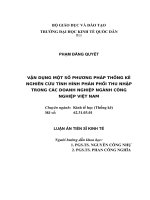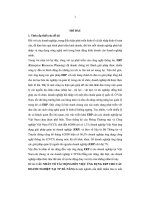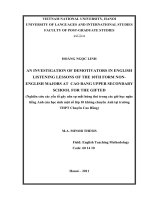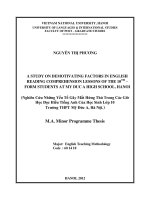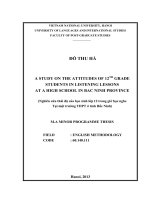Nghiên cứu những yếu tố gây nên sự mất hứng thú trong các giờ học viết của học sinh lớp 10 không chuyên Anh
Bạn đang xem bản rút gọn của tài liệu. Xem và tải ngay bản đầy đủ của tài liệu tại đây (535.01 KB, 7 trang )
VIETNAM NATIONAL UNIVERSITY, HANOI
UNIVERSITY OF LANGUAGES AND INTERNATIONAL STUDIES
DEPARTMENT OF POST GRADUATE STUDIES
*********************
TRẦN THỊ TUYẾT
A STUDY ON FACTORS CAUSING DEMOTIVATION IN WRITING
LESSONS OF 10TH GRADE STUDENTS AT DOAN THI DIEM PRIVATE
HIGH SCHOOL, HANOI
NGHIÊN CỨU NHỮNG YẾU TỐ GÂY NÊN SỰ MẤT HỨNG THÚ TRONG CÁC
GIỜ HỌC VIẾT CỦA HỌC SINH LỚP 10 KHÔNG CHUYÊN ANH TẠI
TRƯỜNG THPT DL ĐOÀN THỊ ĐIỂM, HÀ NỘI
A MINOR M.A THESIS
Field: English Teaching Methodology
Code: 601410
Hanoi, 2010
VIETNAM NATIONAL UNIVERSITY, HANOI
UNIVERSITY OF LANGUAGES AND INTERNATIONAL STUDIES
DEPARTMENT OF POST GRADUATE STUDIES
*********************
TRẦN THỊ TUYẾT
A STUDY ON FACTORS CAUSING DEMOTIVATION IN WRITING
LESSONS OF 10TH GRADE STUDENTS AT DOAN THI DIEM PRIVATE
HIGH SCHOOL, HANOI
NGHIÊN CỨU NHỮNG YẾU TỐ GÂY NÊN SỰ MẤT HỨNG THÚ TRONG CÁC
GIỜ HỌC VIẾT CỦA HỌC SINH LỚP 10 KHÔNG CHUYÊN ANH TẠI
TRƯỜNG THPT DL ĐOÀN THỊ ĐIỂM, HÀ NỘI
A MINOR M.A THESIS
Field: Methodology
Code: 601410
Supervisor: Văn Thị Thanh Bình, M.A
Hanoi, 2010
5
TABLE OF CONTENTS
Declaration …………………………………………………………………………………i
Acknowledgement ……………………………………………… ………………………ii
Abstract ………………………………………………………………………………… iii
Lists of tables and charts …………………………………………………………… …iv
Table of content ………………………………………………………………………… v
PART ONE: INTRODUCTION………………………………………………………….1
1. Rationale…………………………………………………………………………….1
2. Aims of the study………………………………………………………………… 1
3. Scope of the study………………………………………….……………………….2
4. Research questions ……………………………………………………………… 2
5. Method of the study……………………………………………………………… 2
6. Content of the study ……………………………………………………………… 3
PART TWO: DEVELOPMENT ……………………………………………………… 5
CHAPTER ONE: LITERATURE REVIEW……………………………………………5
1.1. An overview on writing…………………………………………………………… 5
1.1.1.General concept…………………………………………………………………5
1.1.2.Teaching English writing………………………………………………………6
1.1.3.Approaches to to teaching writing…………………………………………… 6
1.1.3.1. Controlled-to-free Approach………………………………………………7
1.1.3.2. Free- writing Approach…………………………………………………….7
1.1.3.3. Paragraph- pattern Approach……………………………………………….7
1.1.3.4. Grammar-syntax-organization Approach ………………………………….7
6
1.1.3.5. Communicative Approach …………………………………………………8
1.1.3.6. Process Approach …… ………………………………………………… 8
1.2. An overview on Motivation ………………………………………………………….9
1.2.1. Definition of Motivation …………………………………………………….9
1.2.2. Types of Motivation …………………………………………………………9
12.2.1. Integrative motivation …………………………………………….10
1.2.2.2. Instrumental motivation ………………………………………….10
1.2.2.3. Integrative vs. instrumental motivation ………………………….11
1.2.2.4. Intrinsic motivation ………………………………………………11
1.2.2.5. Extrinsic motivation …………………………………………… 11
1.2.2.6. Resultative motivation ……………………………………………12
1.2.3. Characteristics of motivated students. …………………………………… 12
1.3. Motivation in learning writing …………………………………………………….13
1.3.1. Students’ factors ………………………………………… ………………………13
1.3.2. Teachers’ factors ………………………………………………………… 15
1.3.3. Teaching and learning conditions ………………………………………….17
CHAPTER TWO: RESEARCH AND METHODOLOGY………………………… 19
2.1. Situation Analysis …………………………………………………………………….19
2.1.1. Setting of the study…………………………………………………………………19
2.1.2. Subjects ………………………………………………………………………… 19
2.2. Sample and sampling…………………………………………………………………20
2. 3. Instrumentation………………………………………………………………………20
2.3.1. Instrument 1- Survey questionnaire….…………………………………………… 20
7
2.3.2. Instrument 2- Class observation ……………………………………………………21
Conclusion ……………………………………………………………………………… 21
CHAPTER THREE: DATA ANALYSIS …………………………………………… 22
Introduction ……………………………………………………………………………….22
3.1. Data analysis of the students’ survey questionnaire …………………………………22
3.2. Data analysis of the teacher’s survey questionnaire …………………………………32
3.3. Results from class observations …………………………………………………… 35
Conclusion ……………………………………………………………………………… 39
CHAPTER FOUR: MAJOR FINDINGS AND SUGGESTIONS
4.1. Major findings and discussions …………………………………………………….41
4.2. Suggestions ………………………………………………………………………… 43
PART THREE: CONCLUSION……………………………………………………… 45
REFERENCES ………………………………………………………………………….46
APPENDIX 1
APPENDIX 2
3
ABSTRACT
When teaching writing skill to 10
th
grade students at Doan Thi Diem Private High School, the
researcher found out that Motivating factors are very important and they have significant
effects on students’ writing performance.
Furthermore, due to the application of communicative language teaching method (CLT), it is
clear that students should be well- motivated and activated in learning a foreign language.
Therefore, in learning writing, it is suggested that activities which have been neglected now
should be taken into consideration since it is believed to make the lesson more motivating.
There is no doubt that writing provides students chances to express themselves correctly and
communicatively. But the standard of writing of Vietnamese students is of low qualification
due to the fact that both teachers and students are not keen on writing practice since almost
English tests focus on grammar and reading comprehension instead of writing skill.
In order to motivate students to write as well as improve their writing skill, this study aims to
investigate the factors that cause students’ demotivation in writing skill. Subjects for the study
are 75 10
th
-grade- students of Doan Thi Diem Private High School. This study consists of
three main part: Part I- Introduction, including the Rationale, Aims of the study, Research
questions, scope of study, methods of the study. Part II- this part contains four chapters,
Theoritical background of the study, Research Methodology, Data Analysis and Major
findings and Suggestions. Finally, the researcher offers the summary of the study, limitations
and suggestions for the further research.
PDF Merger
Thank you for evaluating AnyBizSoft PDF
Merger! To remove this page, please
register your program!
Go to Purchase Now>>
Merge multiple PDF files into one
Select page range of PDF to merge
Select specific page(s) to merge
Extract page(s) from different PDF
files and merge into one
AnyBizSoft
